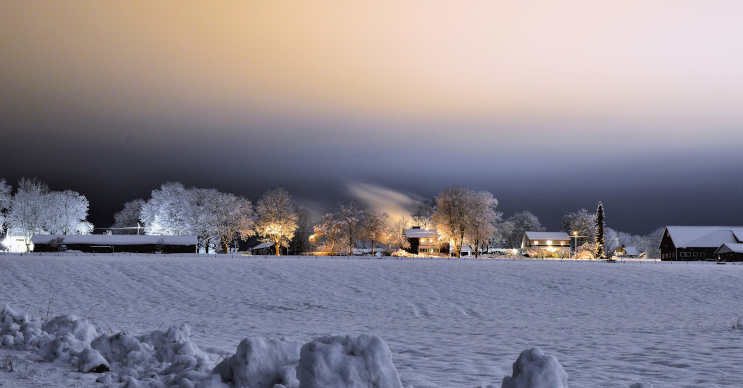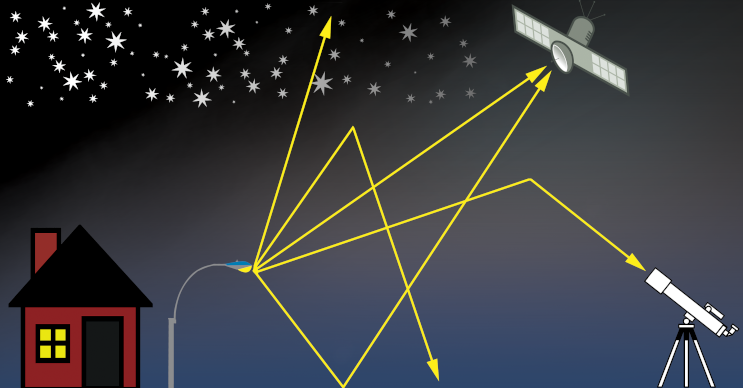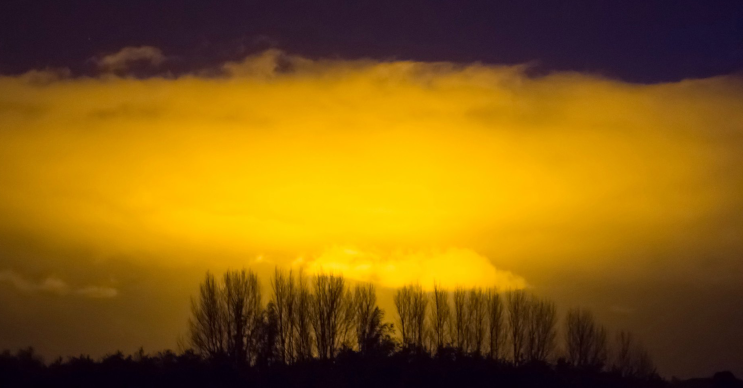Archives
June 2024
Categories
All
|
Back to Blog
Image credit: Jonathan Petersson/Grizzlybear.se 1187 words / 5-minute read Summary: The extent and brightness of skyglow depends significantly on what happens near the ground. Rain, snow and ice can all change how artificial light moves through the nighttime environment, and the way we measure and model light pollution must adapt to ever-changing weather conditions. Winter is underway in the northern hemisphere. For many people who live at northerly latitudes, this means cold weather. There are many factors that effect how bright the night sky is, which we wrote about here and here. (Note that we also previously explored whether holiday lighting is a concern this time of year. ) Winter weather patterns can become of those influences. How do these patterns affect the ways artificial light at night (ALAN) moves through outdoor spaces? And how does this in turn change the brightness of the night sky? How light moves through the atmosphereFrom source to target, outdoor light interacts with the components of the atmosphere. That can change the color of the light, its distribution in space, and other qualities. In the cartoon picture below, light rays emitted from a street light can take various paths before reaching a surface or detector. Some of the light escapes to space where satellites may detect it. Sometimes it reflects off the ground before proceeding up into the night sky. And some light rays end up in our eyes (or, in this case, a telescope lens). But most importantly for our purposes here, the Earth's atmosphere can absorb or scatter light. This happens because constituents of the atmosphere like water droplets, dust particles and molecules are small. That is, they are comparable to the size of the wavelength of visible light. As their size approaches that of the wavelength of light, they interact more light in more pronounced ways. Since the interaction depends on the wavelength of light, the results can vary. For example, very small particles may scatter light of one color in a preferred way. In this way, the atmosphere can direct light to places far from where a lamp emitted it. This can extend the "reach" of city lights into remote locations that are very sensitive to light pollution. Air pollution can make this even worse. Light interaction with cloudsClouds are regions of the atmosphere where the "phase" of water has changed from a vapor to a liquid or solid. As individual water molecules clump together, their optical properties change. So we expect that the way light moves near and through clouds is different than when it moves through clear air. Clouds tend to be gray from a color perspective. That is, as light passes through clouds, the water scatters or absorbs light in ways that don't depend on the light's color. Often when we see clouds in the daytime their tops are white but their bottoms are gray. Both white and gray are the same color, differing only in their intensity. A ray of sunlight reflected from the top of a cloud looks white. But rays emerging from the bottom of a cloud, dimmed from absorption by water droplets, looks much less intense. In light-polluted places, cloud bottoms are bright. They 'amplify' skyglow by reflecting more light back to the ground. Changes to lighting on the ground can change the colors of clouds. In naturally dark places, they're black. They absorb airglow and starlight, both of which are natural sources of light at night. In short, clouds make bright places brighter at night, and dark places darker. Light from a commercial greenhouse in the Netherlands reflects from low clouds at night. Photo by JW van Wessel, licensed under CC BY-NC 2.0. This matters as the world's climate continues to change due to human activities. A warmer climate in much of the world means more clouds. More clouds in turn mean brighter nights both in and beyond cities. We don't yet know what this means for the ecology, but it could be a problem for wildlife conservation in otherwise dark places. Light interaction with outdoor surfacesThe weather also changes the optical properties of surfaces. Imagine materials like dirt, concrete and asphalt. After a rain shower, they all look darker to the eye. The materials absorb water, which in turn makes its refractive index more like that of air. It is then less likely to reflect light rather than absorb it. Surfaces covered by ice and snow tend to look white. The multitude of hexagon-shaped ice crystals that make up ice are great at reflecting (and refracting) light. That means ice reflects much of the light incident on surfaces it covers, making it more and more mirror-like. This effect also amplifies skyglow. Even when the sky is clear, snow and ice on the ground in and near cities makes the night sky brighter. The two effects can combine together, too. One study found that, in an environment with a lot of ALAN, cloudy nights with snow on the ground can be as much as 3500 times brighter than a clear night in a remote location. Such bright conditions have profound effects on the nighttime environment. What this does to measurements and modelsThe effect of weather on our efforts to understand light pollution is significant. One way is by changing the amount of light at night measured by satellites and other remote sensing platforms. A rain-dampened surface can look darker than it is when dry, while an icy surface can increase its apparent brightness as seen from orbit. These effects can add in with others, like changes in leaf cover on deciduous trees, to produce changes in ground brightness that vary according to the season. This effect is evident in satellite data. In winter, with ice on the ground and trees bare of leaves, cities look a little brighter. In summer, the reverse is true. But we can account for this with careful study and correction of our measurements. Weather also impacts our ability to make accurate models of light pollution and skyglow. We now have mathematical models that are very good at predicting skyglow under clear conditions. The physics of light transmission are well-understood. Computing power has increased by leaps and bounds in recent years, and models now run quickly on desktop computers. But it starts to get complicated once the properties of the atmosphere change. The momentary state of the atmosphere then becomes important. We can simulate simple situations, like a uniform layer of clouds over a city. But more realistic weather becomes progressively more difficult to model. We are still far from making reliable skyglow models that deal with weather in believable ways. Darkness is important even in places that are cloudy!With all this talk about weather and skyglow, it's easy to think things are hopeless. Of course we can't do anything about the weather. But even in very cloudy places, where seeing the night sky is rare, it's important to prevent light pollution. Such conditions are "darker than dark" and provide refuge for threatened species. In and near cities, the problem is even more acute due to the amplification of skyglow by clouds. These areas need even more consideration to limit the effects on urban wildlife.
No matter what the weather is like, protecting darkness has distinct social and environmental benefits. Solutions are simple and cost effective, but navigating the complexity of options can be challenging. Every day, we help clients understand the sources of light pollution and their best options for reducing it. Contact us today to find out how we can help you achieve your dark-sky goals.
0 Comments
Read More
|
 RSS Feed
RSS Feed



